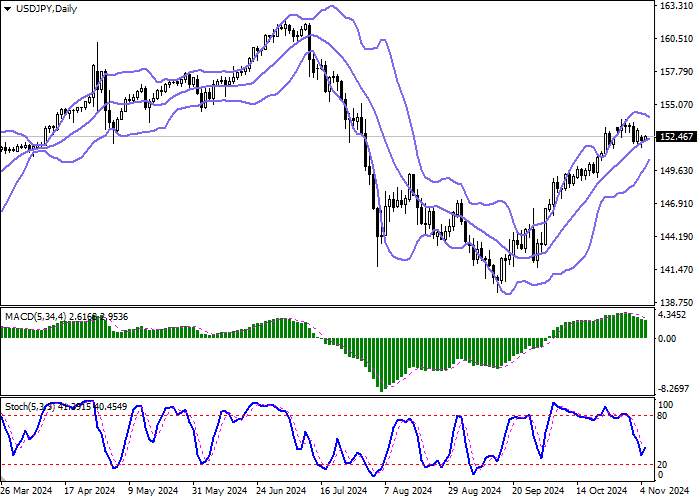Current trend
The USD/JPY pair is correcting in the area of 152.36 after predominantly "bearish" trading the day before, which resulted in local lows from October 25 being updated. The growth of the American currency is strongly limited by expectations of the results of the presidential elections, which are taking place today, but it could receive additional support if the Republican candidate Donald Trump wins. In addition, the US Federal Reserve is set to meet on Thursday, where the interest rate is likely to be cut by 25 basis points. Comments from regulators regarding future monetary policy will also be very important. It is worth noting that markets are counting on another reduction in borrowing costs in December, but there is also a certain correlation with the outcome of the presidential race.
Macroeconomic statistics are exerting moderate pressure on the US dollar. At the end of last week, investors were disappointed by the October report on the labor market: the American economy created a record low number of jobs outside the agricultural sector at 12.0 thousand after 223.0 thousand in September with a forecast of 113.0 thousand. At the same time, the Average Hourly Earnings adjusted from 0.3% to 0.4% monthly and from 3.9% to 4.0% annually, indicating continuing inflation risks in the country. Finally, investors reacted to the decline in the Institute for Supply Management (ISM) Manufacturing PMI in October from 47.2 points to 46.5 points, compared with a preliminary estimate of 47.6 points, while the S&P Global Jibun Bank Japan PMI rose to 49.2 points from 49.0 points.
Meanwhile, the Bank of Japan kept its interest rate at 0.25% last week, signaling readiness to tighten monetary policy further if inflation rises. At the same time, the regulator expects the Consumer Price Index to slow down from the current 2.5% to 1.9% in 2025. Analysts note that the decision to keep borrowing costs unchanged is largely due to the results of the parliamentary elections, which saw the ruling Liberal Democratic Party lose its majority.
In turn, a survey by the Loyalty Marketing Inc. reflected the ongoing pressure on Japanese households: when asked how the country's residents plan to spend their winter bonuses, the most common answer (except for 47.7%, who responded that they either do not receive such payments or are not sure that they will receive a bonus this year) was "savings" — 33.5%, but the share of respondents preserving their capital continues to actively decline since 2019 (from 40.5%). The response "food for every day" reached 6.4%, which is 0.9 points more than a year earlier, confirming that priorities are changing under the pressure of inflation.
Support and resistance
Bollinger Bands on the daily chart show moderate growth. The price range is narrowing, reflecting mixed trading in the short term. MACD is declining keeping a weak sell signal (located below the signal line). Stochastic, having shown an upward reversal near the level of "20", maintains an upward direction, signaling in favor of the development of corrective growth in the near future.
Resistance levels: 152.50, 153.18, 153.87, 154.50.
Support levels: 151.50, 150.50, 150.00, 149.12.


Trading tips
Long positions can be opened after a breakout of 152.50 with the target of 154.50. Stop-loss — 151.50. Implementation time: 2-3 days.
A rebound from 152.50 as from resistance, followed by a breakdown of 151.50 may become a signal for opening of new short positions with the target at 150.00. Stop-loss — 152.50.





Hot
No comment on record. Start new comment.